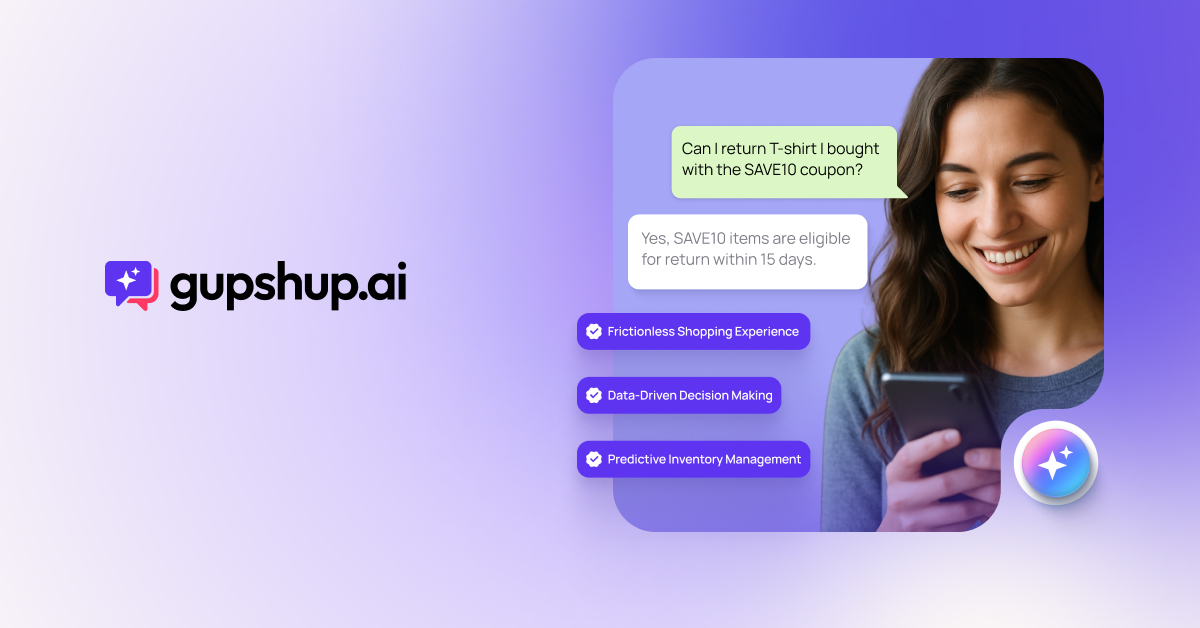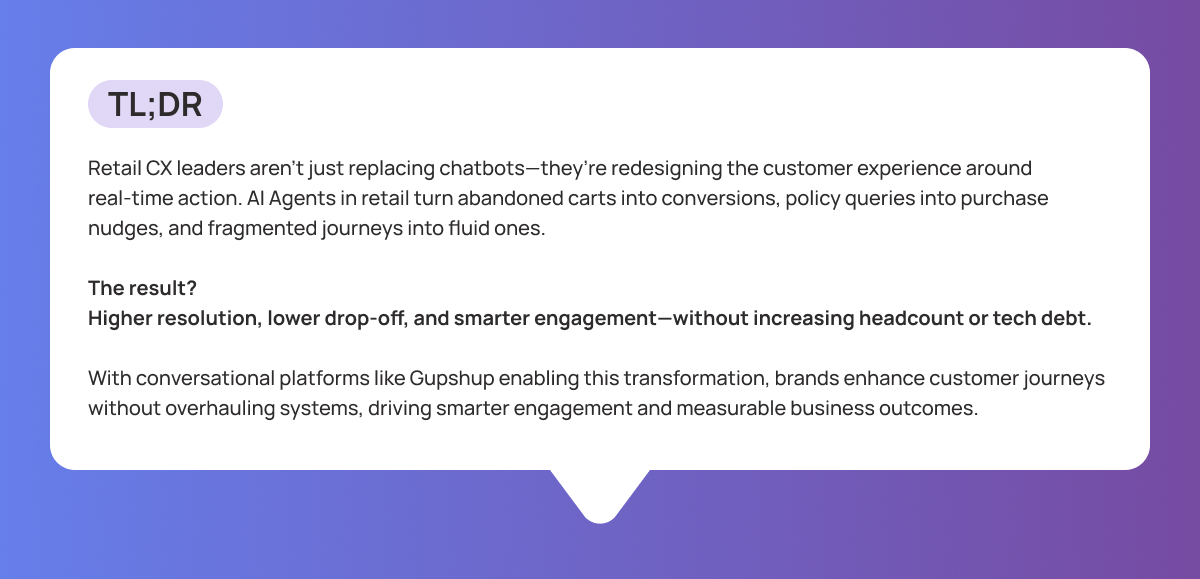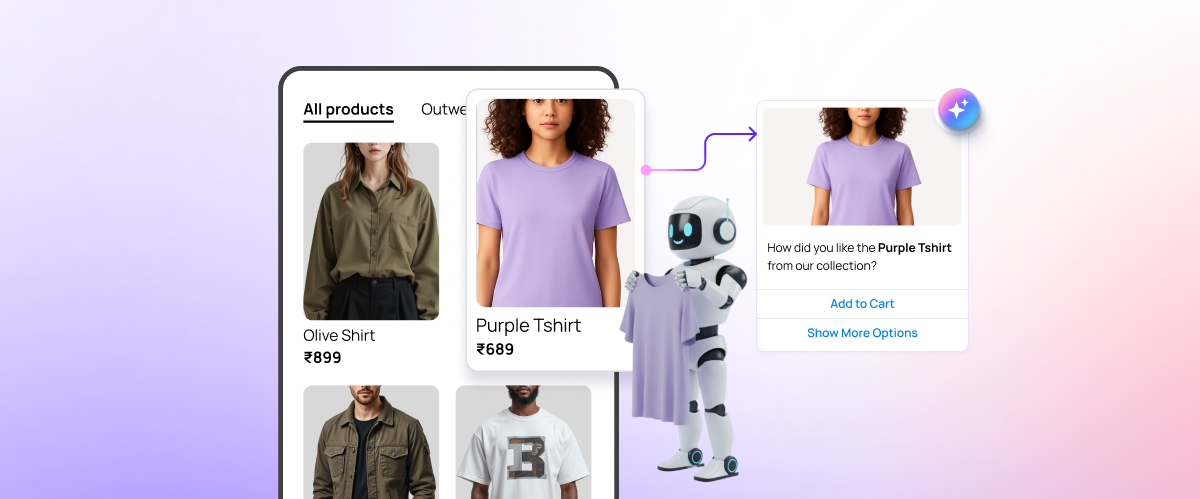Why Retail Customer Experience Leaders Are Transitioning from Chatbots to AI Agents

- Introduction: The Shift Toward Smarter AI Agents for Retail
- The Real CX Tension: Speed vs. Usefulness
- Case in Point: The CX Journey Breakdown
- How can AI Improve Customer Experience?
- Let’s Talk Differently: The “CX Operating Model”
- The Shift Retail CX Leaders Are Making
- What’s Changing in Performance Metrics
- Internal Wins That Rarely Get Talked About
- What This Transition Looks Like (In Practice, Not Theory)
- Final Thought: From Messaging to Momentum
- FAQ
See the power of intelligent conversations for your brand.
Introduction: The Shift Toward Smarter AI Agents for Retail
Over the last few years, retail CX teams have made big moves to automate customer service. Chatbots became the go-to solution, great for handling high volumes and ensuring customers got quick replies.
And for the most part, they did their job. They made support faster and more available.
But somewhere along the way, something got missed. Customers were still running into clunky experiences, getting passed between channels, and not feeling truly understood. Brands started noticing that while bots helped with scale, they didn’t solve for intent or personalization.
At the same time, acquisition costs (CPL and CPA) kept rising. And with budgets under pressure, increasing customer lifetime value (CLV) became more important than ever.
That’s why more and more CX leaders are shifting gears—from basic chatbots to smarter, more capable AI Agents in retail. These agents don’t just answer questions—they connect the dots, understand context, and help create smoother, more valuable customer journeys.
This shift isn’t about chasing the next shiny tool. It’s about building better experiences that move the needle for customers and the business.

The Real CX Tension: Speed vs. Usefulness
Speed has always been a priority in customer service. Faster replies and instant responses—that’s what automation promised and largely delivered. But for CX leaders in customer experience in retail, a deeper challenge remains: how do you balance that speed with usefulness?
In other words: is the reply fast AND helpful? Or just fast?
Most retail brands have automated customer support. But customers still leave frustrated.
Why? Because fast replies don’t always equal meaningful ones.
What is the problem with speed-focused automation?
Chatbots were built to reduce response times. They handle routine questions, give pointed responses, and free up agents. But they often fail to move the conversation forward, especially when context matters.
For example:
- “Where’s my order?” → The bot answers with order status.
- “Can I return it if I use a promo code?” → The bot redirects to a policy page.
- “What if I want to pick it up from a nearby store today?” → The bot stalls or deflects.
That’s three questions in the same journey and three missed chances to create continuity and build a loyal relationship with a customer.
This is a problem that Conversational AI Agents were built to solve.
How are AI Agents for Retail are changing customer service?
Like chatbots, Conversational AI Agents don’t rely on rigid flows. They use real-time data retrieval, language understanding, and session memory to respond with clarity and precision.
Here’s how they perform better:
Customer asks: “Can I return shoes I bought with the SAVE10 coupon and pick up a new pair in-store today?”
| What Happens | Traditional Chatbot | AI Agent |
| Coupon logic | Forwards return policy | Pulls coupon rules from backend: “Yes, SAVE10 items are eligible for return within 15 days.” |
| Store pickup | Breaks script | Checks live store inventory: “You can pick them up from the Juhu store today till 8 PM.” |
| Next step | Asks the customer to call support | Offers a link to schedule pickup or initiate a return |
A retail AI agent immediately provides a resolution.
Under the hood, this is powered by what’s known as a RAG pipeline (Retrieval-Augmented Generation), where the agent pulls real-time data from backend systems before generating a reply, making the response both fast and informed.
Why smarter AI Agent support matters more than speed
AI for the retail industry is closing the gap between reactive replies and strategic resolution. Instead of measuring success only through speed or ticket volume, CX leaders now use KPIs reflecting business impact. These metrics reveal how effective AI Agents are at turning customer conversations into conversions, recoveries, and loyalty-building moments.
CX leaders aren’t just looking at NPS scores anymore. They’re tracking:
- First-contact resolution (FCR): AI Agents consistently boost this metric.
- Drop-off recovery: Retargeting based on intent signals (like cart abandonment + product search).
- Revenue per conversation: More relevant replies = more conversions.
CSAT and retention: Context-aware support directly correlates with loyalty
Case in Point: The CX Journey Breakdown
Most chatbots operate in silos. This leads to broken journeys.
- A customer discovers a product
- Mid-checkout, they ask a return policy question
- They click “back” to compare options
- They lose the cart
- They receive a generic follow-up email days later
These broken journeys aren’t rare—they’re the norm. Customer experience in retail often suffers because customers bounce between tabs, devices, and channels, expecting continuity. But most systems weren’t built for that. The result? Disjointed experiences that feel anything but seamless.

Where Chatbots Fall Short
Traditional chatbots work well when users follow predictable flows. But they break when a customer asks a layered question, returns after a break, or expects their earlier context to be remembered. They don’t integrate deeply with backend systems, so a question like “Can I return this if I used a coupon?” gets a generic link instead of a tailored answer.
This is where AI Agents come in—not as chat replacements, but as intelligent orchestrators of the entire customer journey.
What we’re seeing isn’t just an evolution in tooling; it’s a redefinition of CX ownership. The most advanced retail brands treat AI Agents not as support extensions, but as full-funnel experience engines. That means:
| Legacy Approach | New Approach (with AI Agent in retail) |
| Email blasts to static segments | Personalized nudges triggered by live behavior |
| Product detail inquiries | Guided product discovery with context |
| Post-order updates | Proactive resolution with backend integration |
| Reactive support handling | Anticipatory help based on journey signals |
In practice, a user clicking on a campaign ad can be greeted in chat with the product they viewed, shown reviews for similar items, and guided to conversion with zero handoffs or context loss.
This alignment between marketing campaigns and AI-powered support is closing the gap between intent and transaction, and reducing drop-offs at every stage. For any brand exploring AI for retail industry growth, this model delivers long-term CX impact.
How can AI Improve Customer Experience?
Most teams think of bots as a feature inside support. But AI Agents are changing that mindset. They’re not just sitting at the edge of the experience—they’re becoming the connective layer across journeys, channels, and systems.
That’s what makes them a new CX operating model. They don’t just automate—they coordinate. They don’t just answer—they act. And they do it by pulling data, context, and signals together in real time.
Artificial Intelligence transforms customer experience from reactive service to predictive, personalized engagement by connecting systems, understanding intent, and delivering meaningful interactions at every stage of the retail journey, especially when powered by a retail AI agent that bridges systems and touchpoints.
The real cost of fragmentation
Retail funnels look linear on dashboards, but real customer behavior rarely is. A shopper might:
- Discover a product via Instagram.
- Add it to their cart on mobile.
- Ask about the return policy through chat.
- Compare alternatives on the desktop.
- Abandon the cart.
- Receive a retargeting email that doesn’t match their intent.
Each of these moments is a signal. But when systems aren’t connected, signals get missed. What you see as a funnel, your customer experiences as friction.
The strategic case for AI Agents for the retail industry
Retail AI Agents are intelligent orchestrators of the customer journey.
Here’s what they enable:
- Journey continuity across touchpoints: From WhatsApp to web chat to email, AI Agents preserve session context and customer history.
- Context-aware assistance: Mid-cart policy queries? Inventory questions post-purchase? The agent responds with relevance, not repetition.
- Live integration with backend systems: Orders, carts, preferences, delivery status, all accessible in real time.
- Dynamic re-engagement: Not just “abandoned cart” emails, but personalized WhatsApp nudges based on behavior and timing.
Success Story: Wolford Boosts Online Sales with Gupshup’s Multilingual AI Agents
Luxury skinwear brand Wolford, present in over 45 countries, partnered with Gupshup to streamline its global customer support and digital shopping experience.
To address challenges like fragmented product discovery and language barriers, Wolford deployed Gupshup’s AI-powered Shopping Assistant, offering:
- Smart product search and automated size finders
- Conversational support in 100+ languages
- Human-like guidance for high-intent shoppers
Results:
- 3% increase in quarterly online sales
- Faster, more intuitive support across time zones
- Reduced pressure on human agents without compromising CX
CX isn’t just a function—it’s infrastructure
The most forward-thinking retailers no longer treat CX as a post-sale service layer. They’re building customer experience infrastructure, where AI Agents are the connective link between marketing, commerce, and support.
AI Agents are not just a response to customer frustration. They’re a force multiplier across funnel stages:
- Top-of-funnel: Personalized product discovery and education.
- Mid-funnel: Real-time objection handling and guided conversions.
Post-purchase: Loyalty building, issue resolution, and cross-sell orchestration.
Let’s Talk Differently: The “CX Operating Model”
AI Agents aren’t just the next step in chatbot evolution—they represent a shift in how customer conversations are designed, delivered, and scaled. Think of them less as support tools, and more as the foundation for a new CX operating model.
Traditional bots work in isolation. They follow scripts, handle FAQs, and escalate when things get complicated. But AI Agents? They operate with intent. They’re built to understand what the customer wants, retrieve the right data in real time, and respond with relevance—not repetition.
They don’t just automate tasks—they orchestrate outcomes.
This change reframes the entire approach to CX. Instead of reacting to tickets, brands can proactively guide shoppers. Instead of siloed support and marketing systems, Agent AI acts as connective tissue, pulling together context, behavior, and backend data to deliver intelligent and effortless experiences.
From Automation to Strategic Engagement
This is the big shift: from automation for efficiency to AI for strategic engagement. AI Agents use RAG and real-time system integration to power conversations that are timely, personalized, and purposeful.
They can:
- Surface return eligibility based on coupon use
- Recommend in-store pickups based on live inventory
- Initiate returns, upsells, or reminders based on behavior
The result? Conversations that don’t just resolve queries—they move the customer forward in their journey, powered by a context-aware AI agent in retail.
The Shift Retail CX Leaders Are Making
Retail CX leaders aren’t just swapping out their chatbots—they’re redesigning their approach to customer experience.
It’s not about bolting on new tech. It’s about rethinking the actions that matter most to customers—and building systems that respond in real time, across moments that matter.
Here’s how the best retail brands are shifting:
| From | To |
| Broadcasting campaigns | Personalized nudges triggered by behavior |
| Answering product questions | Helping shoppers find what fits |
| Order tracking | Autonomous issue resolution |
| Team overload | AI Agents resolving 60–70% of Tier 1 + Tier 2 issues |
In this new model, AI Agents don’t just reduce support load—they drive meaningful engagement. Whether it’s a cart recovery nudge on WhatsApp, a smart assistant guiding product discovery, or an issue resolved before the customer even reaches out, the value is clear: better customer experience in retail, fewer drop-offs, and more conversions.
What’s Changing in Performance Metrics
Marketing and CX teams are under pressure to prove their tech stack drives measurable ROI. The shift to AI Agents has forced a rewrite of what “good” looks like, not just in service, but across the customer lifecycle.
New metrics are emerging:
- AI-led resolution rate: Measures how much Tier 1/Tier 2 volume is resolved without human involvement
- Drop-off recovery conversion: Tracks re-engagement and conversion of abandoned sessions or carts
- Personalization uplift: Quantifies conversion delta between standard vs. AI-personalized flows
- Customer lifetime lift: Links journey continuity and proactive care to longer retention cycles
These are not soft metrics. They’re directly tied to revenue protection, efficiency gains, and campaign performance improvements.
Internal Wins That Rarely Get Talked About

The benefits of AI Agents don’t stop at customer-facing touchpoints. Internally, they are reshaping how CX and marketing teams work together and work faster.
- Marketing autonomy: Campaigns can be launched with embedded AI-powered conversations that directly handle objections, drive purchases, and collect preferences, without dev cycles or multiple tools.
- CX agility: Journey logic no longer requires engineering to update. CX teams can adapt flows in minutes based on real-time feedback or new business priorities.
- Product consistency: With AI Agents driving conversations across chat, voice, app, and web, customer experiences stay brand-safe and coherent, without duplicating effort across teams.
This means fewer silos, faster execution, and clearer ownership. Agent AI is becoming the connective layer between acquisition, engagement, and retention strategies.
What This Transition Looks Like (In Practice, Not Theory)
The path from chatbot to AI Agent can’t feel like a full-stack rebuild—it has to feel modular, testable, and ROI-driven from day one.
The smartest teams aren’t overhauling overnight. They’re layering AI Agents into high-intent, high-friction moments first, then scaling based on proven outcomes.
Here’s what a real-world rollout looks like:
- Start small, win big: Deploy a Product Finder Agent on PDPs or a Cart Recovery Agent post-abandonment. These touchpoints are measurable and directly tied to conversion outcomes.
- Run controlled A/B tests: Compare AI Agent flows with traditional logic trees. In most cases, the uplift in engagement and purchase rates is immediate and defensible.
- Trigger based on live behavior: Instead of waiting on form fills or email opens, trigger WhatsApp nudges for users who viewed 3+ SKUs and bounced. These moments are where most revenue is lost, and AI Agents are best equipped to recover it.
- Integrate, don’t rebuild: Using platforms like Gupshup, marketing and CX teams can connect agents to payments, CRMs, and support stacks via modular APIs—without heavy development. This makes AI an enabler, not a bottleneck.
- Turn feedback into fuel: Every conversation with an AI Agent becomes a learning opportunity. Use those insights to optimize offers, refine segmentation, and personalize the next touchpoint.
The progression is clear: from one use case → to one channel → to one stack-wide advantage. This is the practical path to turning automation into growth infrastructure.
Success Story: How Reserva, Brazil’s Leading Fashion Brand, Achieved 7X ROI with Gupshup’s AI-Powered Conversational Marketing
Brazil’s leading fashion brand, Reserva, partnered with Gupshup to reimagine its customer engagement strategy. Using Gupshup’s Conversation Cloud integrated with their VTEX platform, the brand:
- Sent personalized WhatsApp campaigns to CRM segments
- Triggered abandoned cart alerts based on real-time events
- Replaced low-performing emails with 40% CTR WhatsApp messages
- Automated 95% of post-purchase updates via WhatsApp
They also launched a Generative AI assistant for product discovery, which guided shoppers with contextual upsell recommendations, just like an expert store associate.
Impact:
- 7X ROI from online sales
- 4X engagement lift
- Up to 46X ROI from cart recovery campaigns
- 2,000+ leads via click-to-WhatsApp ads in just 30 days
Final Thought: From Messaging to Momentum
The future of CX will not be defined by who has the best chatbot. It will be defined by who acts fastest on intent, who moves the moment a customer shows interest, asks a question, or hesitates at the edge of conversion.
AI Agents give brands that capability:
- To turn signals into conversations.
- Conversations into actions.
- And actions into outcomes.
They collapse friction and surface value and recover revenue, not in a support ticket but in a single, intelligent message.
This is no longer about messaging infrastructure. It’s about momentum.
Ready to future-proof your retail CX?
Start with a high-intent moment—product discovery, cart recovery, or re-engagement—and see how fast the conversation turns into conversion. Explore how Gupshup makes AI Agents work for retail.
FAQ
How is AI transforming customer experience in retail?
AI enhances retail CX by personalizing shopping experiences, streamlining operations, and providing real-time assistance, leading to increased customer satisfaction and loyalty.
What are the key benefits of AI in improving customer experience in CRM?
AI in CRM automates tasks, offers predictive insights, and personalizes interactions, resulting in improved customer engagement, reduced churn, and enhanced sales forecasting.
How will generative AI impact marketing?
Generative AI revolutionizes marketing by automating content creation, enabling personalized campaigns, and accelerating consumer research, thereby enhancing efficiency and engagement.



 +91-9355000192
+91-9355000192 Login
Login





